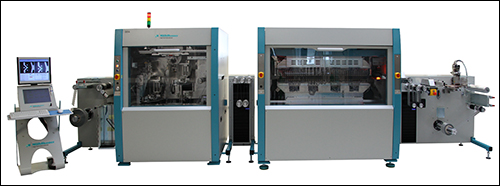Mühlbauer has developed several new products aimed at making RFID inlay manufacturing faster, greener and more cost-effective. The ACS 100 and 350 antenna cutting system, released this year, allows a fast alternative to etching, the company reports; it also reduces material costs and is more environmentally friendly.
The DDA 40000 is the latest and fastest version of the company’s “flip-chip” machine, to provide a simpler and more efficient method of attaching a chip to a substrate, accomplishing 40,000 inlays per hour on a single row. That device, the company says, moves it forward on its roadmap to enable the production of 100,000 inlays per hour by 2020 in a multi-row and Internet-based system (if market growth requires such high-speed machines).
Mühlbauer provides the production equipment that companies can use to create smart labels and contactless cards in-house. It provides what it calls the RFID Factory—not only antenna printing, but also the machinery that assembles the inlay itself, including the flip-chip attachments onto each inlay, as well as converting and personalization, according to Thomas Betz, Mühlbauer’s managing director.
When it comes to RFID label antennas, most are created by etching conductive layers onto the antennas, which are typically made of copper or aluminum. This, Betz says, is not an environmentally friendly process. It requires the use of corrosive chemicals, as well as chemical-resistant materials, and then a washing procedure to clean the acid off the finished antenna. This process is slow and inefficient, says Gerald Niklas, Mühlbauer’s product manager. The multiple processes around the chemical use are time-consuming and create contaminated materials that need to be disposed of.
On the other hand, Betz says, “Ours is a mechanical process.” The antennas are cut according to specifications, directly from the aluminum, and the unused metal can then be containerized and recycled, based on the specific requirements in the user’s country or state. Because no chemicals are used, there is no concern related to the disposal of toxic liquids, or the metal parts contaminated by them. There is also no need for chemical-resistant material, Niklas adds, and no fumes from the cutting process.
The system consists of a milling wheel that mechanically removes all unnecessary aluminum parts and leaves the desired antenna pattern. A UHF testing system built into the cutter verifies the antennas, while an inkjet printer marks any bad antennas with a black dot during this process so that it can be removed prior to the building of the inlay.
“Our target is to offer a green process,” Niklas says, not only by providing a cleaner, mechanical process, but by enabling the work to be carried out in-house by its customers. By employing the cutting machine for tag fabrication in-house, he notes, users can accomplish a much faster antenna creation process without the shipping cost and time required if a third party were to etch the antennas elsewhere, such as in Asia.
The Direct Die Attach (DDA) flip-chip machine and the technology it leverages are not new; Mühlbauer released the first version of this product three years ago, and Niklas estimates that approximately 50 of the tag-making machines are currently in use around the world. The DDA 40000, however, doubles the productivity of the first version.
The DDA flip-chip system employs a process by which the silicon wafer (with integrated circuits on it) is turned upside down in the machine so that the top side of the chips faces down, over the RFID inlays. As it passes under the wafer, the chip is released directly onto each antenna, and an adhesive then bonds the chip to the antenna to create that inlay. This contrasts with traditional methods by which wafers are stored upright, and the chips must be picked and placed—first removed from the wafer with one tool, and then placed on the inlay with a second.
The DDA flip-chip machine provides a 300 percent higher throughput with a 30 percent smaller footprint than traditional inlay-building machinery, the company reports, and accomplishes an 80 percent lower die-attach cost. To make a flip-chip-enabled machine that is faster, the firm has been redesigning the system with a different type of glue that dries faster (the previous system could complete a single inlay within six to eight seconds, with most of that time required for drying the glue). With the DDA 40000, the glue dries in about a second, so that each inlay can be created within one to two seconds.
Several companies are testing the new DDA 40000 system in their inlay manufacturing systems, including several businesses headquartered in in Asia, Europe and a U.S. firm that operates in Asia. The machine represents the fastest flip-chip method-based system for RFID inlay manufacturing, Niklas reports.


